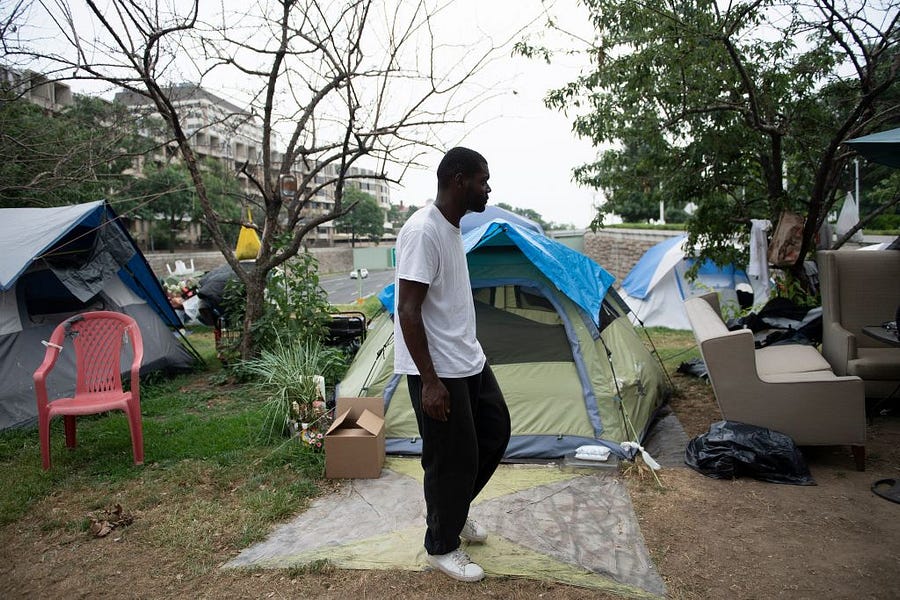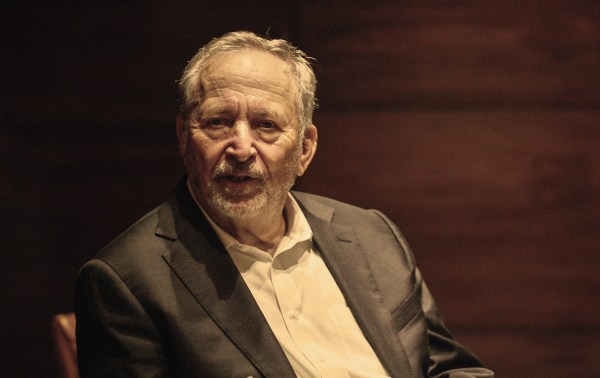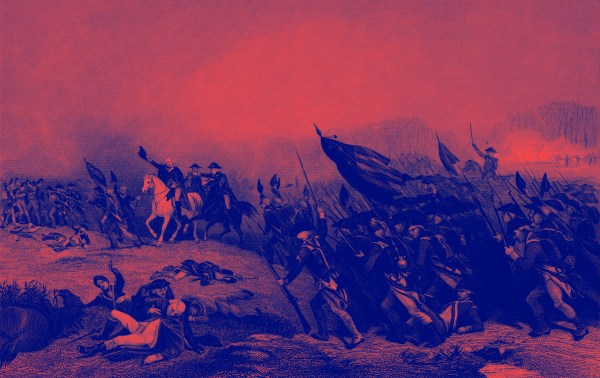Over the last 18 months, the COVID pandemic has been accompanied by a series of fierce political battles over the policy measures put in place around the country to blunt the dangers of the disease. Thanks to the ongoing march of the vaccines (and barring the arrival of any more variants), the total-war phase of the pandemic may be at its end—but the next round of fighting over what to do with COVID policies now is just getting started.
One of these fights is currently playing out in Washington, D.C., over an issue that is fraught at the best of times: city (and federal) policies concerning homelessness. Camping on public land is illegal in D.C. But since the beginning of the pandemic, both city police and the National Park Service have stopped enforcing this prohibition, citing CDC guidance to “allow people who are living unsheltered or in encampments to remain where they are.”
Now, as D.C. has begun moving slowly back to normal—the city recently extended Mayor Muriel Bowser’s authority to keep the city in a state of emergency, but the official public health emergency has ended—the agencies involved have been remarkably silent on what’s coming next.
If you’ve ever been to D.C., you’ve probably been struck by the city’s cattywampus layout, which dates back to Pierre L’Enfant’s 18th-century design: an irregular north-south and east-west grid crisscrossed by a network of long diagonal streets and traffic circles. One consequence of this layout was the creation of dozens of parcels of land too small to build on. Each of these small spaces is designated as federal parkland, and their upkeep is overseen by the National Park Service.
It’s these mini-parks that are now causing the most discord among D.C. residents. Like most American cities, Washington has long struggled with problems related to homelessness. But camping nonenforcement has magnified the ordinary social frictions involved, as encampments of a dozen or more tents have sprung up on small pieces of land wedged in the middle of commercial or residential districts.
These encampments emerge spontaneously, but once established are in large part self-sustaining. For homeless people, who are particularly vulnerable to violence and other crime, camping with others can offer a layer of community protection they would lack sleeping alone. An established encampment is also a magnet for various forms of social assistance, since organizations that help the homeless tend to go where the people are. That goes double during the pandemic, when the city has tried to establish a baseline for hygiene by placing portable toilets and handwashing stations at various encampments around the city.
But as D.C.’s pandemic policies have stretched on, some residents and businesses have grown impatient with what has increasingly felt like a permanent suspension of camping laws. Back in June, a number of businesses in the Stanton Park neighborhood along Massachusetts Avenue, near D.C.’s Union Station, wrote a letter to Mayor Muriel Bowser and Secretary of the Interior Deb Haaland, asking them to take action to remove two large encampments that had sprung up in their midst.
The dozen signatories to the letter included entities as disparate as a local liquor store, supermarket, restaurants, and barbershop, the headquarters of the Heritage Foundation, a satellite campus of conservative Hillsdale College, and the Capitol Hill Business Improvement District. While the signers said they “have patiently and supportively accepted the dire situation of homeless individuals and their decision to occupy neighborhood parks due to a lack of more appropriate shelter” over the past year, they argued the time had come “to restore these parks to the public and ameliorate the unsafe, inhumane, and unsanitary conditions that have been endemic to the occupants of these tent communities.”
“Public urination and defecation are rampant due to a lack of sanitary infrastructure,” they go on. “The absence of adequate running water has caused encampment residents to use the local businesses as a source for drinking and bathing. Trash from the tents spills out into the streets. … Syringes and used drug paraphernalia are now routinely found on the sidewalks and in the public alleys nearby. … Most important of all, the human toll is dire, with people living on the street, in need of so many social services that should be provided for them at appropriate facilities.”
“That’s federal property, so [city police] say they can’t do anything,” Lynn Dang of Capitol Hill Barber & Stylist, one of the Stanton Park businesses that signed the letter, told The Dispatch. “The federal police say they’re too busy.”
Not all D.C. residents feel the same way, of course. In some neighborhoods, activists for the homeless and community groups have lobbied the city and NPS to continue nonenforcement of rules against encampments, arguing that breaking up tent encampments won’t solve underlying problems of homelessness.
“I think it’s just coming to a head,” Advisory Neighborhood Commissioner Alexandra Bailey told local news station WUSA9 last month. “As we have gentrified neighborhoods, we have created an even bigger gap between people who have and who have not.”
Caught between two groups of residents and organizations at loggerheads on the encampments, law enforcement—rather than offering clarity on its plans—has moved in a series of fits and starts. In late June, the Park Police told community groups it planned to break up an encampment in Burke Park “after July 4.” After an outcry from Bailey and other activists, however, NPS backtracked, saying in a statement it had “no imminent plans to remove existing encampments.”
“Now that the vaccine is widely available and there are spaces available in city housing and shelters, the NPS is beginning the process to address public health and safety concerns, as well as damage to park resources, in several parks across the city,” NPS said in its statement. “Prior to taking any action that would affect people living in encampments we will give individuals ample notice.”
Over the weekend, police unexpectedly moved on one encampment: the one at issue in the Stanton Park letter. On Saturday morning, officials started erecting fencing around the encampment; a D.C. group that aids the homeless, Good Trouble Cooperative, told The Dispatch that former residents of the encampment had been given only a few hours’ warning that the space was to be cleared. Not all were able to remove their belongings—behind the fence, several tents remained standing, surrounded by chairs, bins, pillows, and other items.
“Everyone just left so hurriedly—there’s just so much left behind. Because folks were just basically told to like grab their shit and go,” Beyoncé X., an organizer with Good Trouble Cooperative who goes by a pseudonym in her activism work, told The Dispatch. “To me it seems that this is just a precursor for events to come.”
What was particularly strange was the stated purpose NPS gave for breaking up the encampment. It had been done, according to a notice posted at the site, not because of the concerns raised by Stanton Park residents or because of the legal ban on camping, but because some trees needed pruning: “Certified arborists have identified hazards from two declining Linden trees,” the notice read. “These trees pose a potentially serious risk to public safety because of their condition, location, and the number of people who use the area. The park will be enclosed with fencing and will remain closed until the safety hazard and other resource damage is addressed.”
That was Saturday; as of this writing, the fencing remains up around the park. Other prominent encampments so far remain uncleared. (The Park Police did not respond to multiple requests for comment for this piece.)
Reading the NPS’s July statement, you might well come away thinking that D.C.’s homeless shelters were only just beginning to have the capacity to house the city’s homeless residents again. But shelter organizations told The Dispatch there was never a shortage of shelter space during the pandemic. Rather, those who stayed outside were by and large the same sort of people who tend to shun shelters in ordinary times—because they chafe at the comparatively rigid organizational structure, for instance, or because they suffer from mental illnesses like paranoia or schizophrenia.
“When you’ve been out on the street for years or decades, you become acculturated to that lifestyle,” said Joseph Mettimano, president of Central Union Mission, a Christian organization in D.C. that operates a shelter and various other aid programs for the homeless. “And what that means is that you don’t live by anybody else’s rules or anybody else’s time clock. Well, shelters have rules, and shelters have check-in times and wake-up times and go-to-sleep times and lights out. … My preference is I don’t want to see anybody sleeping on cardboard out on the street. I’d rather that they were here with me, that they had a nice soft bed, air conditioning, and three hot meals. But everybody makes their choices.”
The bottom line is that the Park Police’s apparent strategy—running out the clock and hoping the issue of encampments goes away on its own—is only a method of kicking the can down the road. Indeed, the problem is likely to get worse before it gets better. The D.C. Department of Health and Human Services said back in April that the number of chronically homeless people in the city rose 21 percent last year compared to a year prior. And another deadline is looming: The end of the federal government’s ongoing eviction ban.






Please note that we at The Dispatch hold ourselves, our work, and our commenters to a higher standard than other places on the internet. We welcome comments that foster genuine debate or discussion—including comments critical of us or our work—but responses that include ad hominem attacks on fellow Dispatch members or are intended to stoke fear and anger may be moderated.
With your membership, you only have the ability to comment on The Morning Dispatch articles. Consider upgrading to join the conversation everywhere.